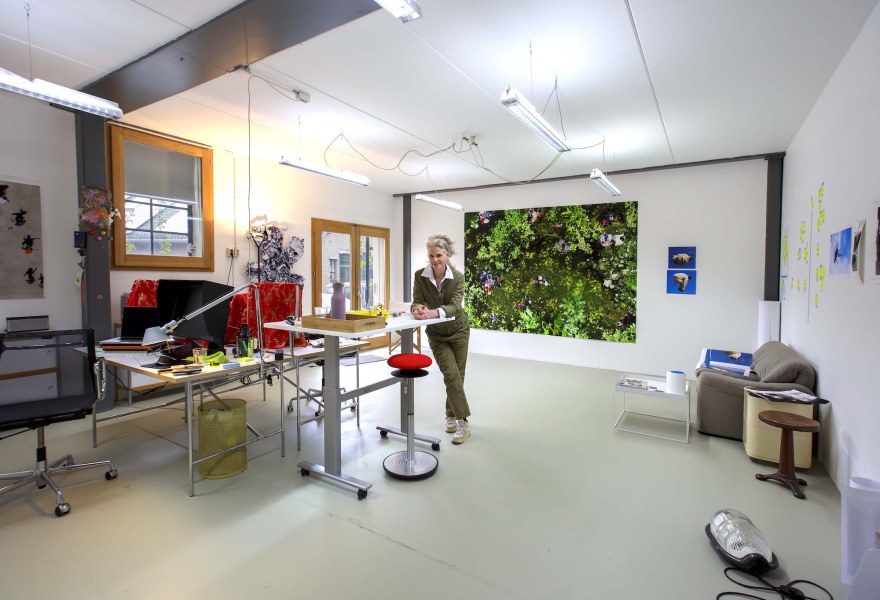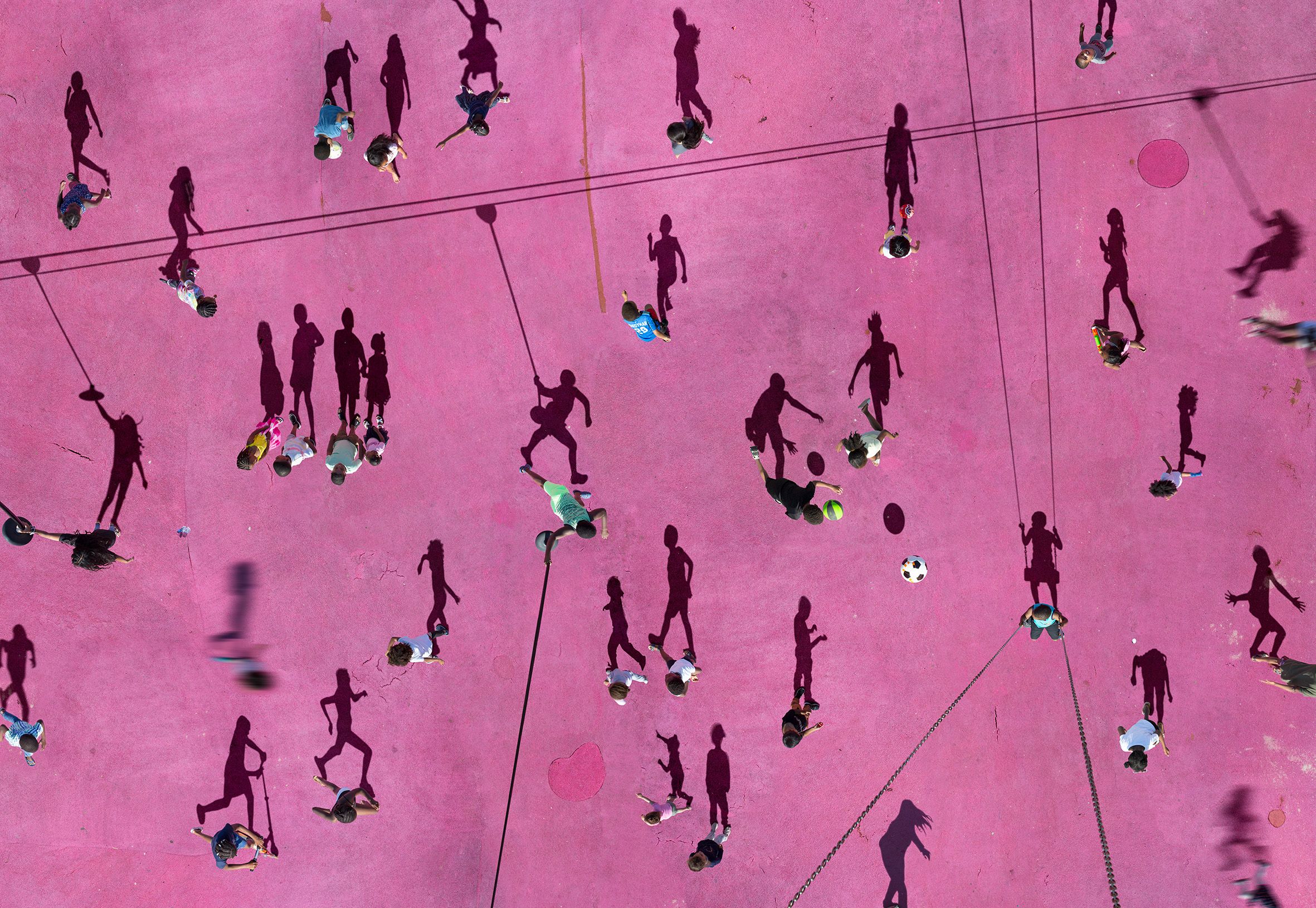28 april 2025, Martine Bontjes
The studio of… Katrin Korfmann
Katrin Korfmann transforms public spaces into evolving studios, where the urban city becomes part of her workshop. She intervenes in public spaces by constructing tall cranes, assembling installations, and collaborating with people who pose for her as her models. Korfmann explores how people claim urban spaces and use them for purposes that diverge from their original initial aim. In her solo exhibition 'Augenblick', on view at Bradwolff & Partners until 3 May, Korfmann captured dancers, surfers and freerunners. Her photographs comment on urban interaction: “They remind us that public spaces are at the heart of human communities and essential to living together”.
Until the end of June, Korfmann’s work will be exhibited at the Noordbrabants Museum in the exhibition 'Doorzetters' ('Perseverance'), about the power of sport. On Saturday 3 May at 4 PM, Korfmann will engage in a conversation with Ranti Tjan (Head of Collections and Exhibitions at the Noordbrabants Museum) at Bradwolff & Partners in Amsterdam.
Where is your studio located, and how did you come to work there?
My studio is located at De 1800 Roeden in Amsterdam, near the Tuinen van West. It’s a former munitions depot that has been beautifully repurposed into studios, ateliers, and workshops. I’ve been there for fifteen years. My husband, Jens Pfeifer, already had a studio there, and when the one next to his became available, I seized the opportunity. It’s a wonderful place with lots of greenery on the edge of the city.
What does a typical workday in your studio look like?
It really varies from day to day. Usually, I cycle to the studio, it’s a beautiful route through parks, and during the ride, I already start thinking about different projects and how my day will unfold. I spend quite a bit of time behind the computer, viewing, sorting, editing photographs, writing texts, communicating about ongoing and future projects, listening to lectures, packing and unpacking works, hanging art, or welcoming visitors. The studio space is very inspiring for me. In addition to all the equipment, there’s a couch, books, a lovely window with views of greenery, and I’m surrounded by artworks on the walls that I constantly reflect on. I also consider the public spaces where I make my recordings as extensions of my studio: studios that are constantly evolving.
You are currently working on a PhD at the Academy of Creative and Performing Arts in Leiden, focusing on temporality in photography. How does this research relate to your visual practice, and what exactly are you exploring?
For me, time and space have always been the most fascinating aspects of photography. The spatiotemporal frameworks of current digital photographic technologies fundamentally differ from those we are accustomed to. My PhD project "Photographic Times" seeks, through artistic practice, to explore future photographic temporalities and perspectives, investigating the shifting technophotographic relationship to time.
By considering photographic time beyond exposure time alone, I examine the relationship between time and photography across three aspects:
- the ‘temporality of making’, photographic practice and technology
- the ‘temporality of representing’, the photograph or code itself
- the ‘temporality of experiencing’, as manifested in viewer interpretation
"Photographic Times" questions what photographic temporality means in the age of AI and machine learning, where the speed of traditional photography is replaced by algorithms and the photographic image emerges as code, navigable across multiple perspectives.
In your solo exhibition 'Augenblick' at Bradwolff & Partners, you present snapshots that emerge from prolonged observation — from surfers in Munich to dancers in Amsterdam’s Oosterpark. How do you determine the decisive moment?
In the works shown in 'Augenblick', I aim to disrupt our conventional understanding of the photographic moment by creating compositions where temporal dimensions collapse. The works undermine Henri Cartier-Bresson’s idea of the 'Decisive Moment' [the famous French photographer stated that there is a perfect, fleeting moment when all the elements in a scene come together to create a powerful and meaningful photographic image, ed.]. I do that by constructing layered visual narratives in which urban spaces become stages for human performance and social interaction. Photographic indexicality [the notion that a photograph is a direct trace or imprint of something that existed in reality, ed.] and interpretation are rooted in the language of photography's past. I am interested in playing with and undermining this language, especially its relationship to time and space, by drawing attention to its boundaries. I want to challenge the viewer’s interpretation of a photograph.
My work investigates and imagines how people claim and reinterpret urban spaces according to their interests and needs. In central Munich, surfers have claimed the Eisbach — a narrow, man-made river with a permanent wave — connecting the water to their own movements. The freerunners in Amsterdam navigate the city by using public spaces creatively, appropriating the environment for different purposes than originally intended.
Your work often unfolds in public spaces — on streets, in parks, and squares. What drew you to Nelson Mandela Park in Amsterdam Zuidoost, and why did you choose to capture the image of children playing there?
During the pandemic, I had the opportunity to participate in the BijlmAIR artist residency, a program by CBK Zuidoost in collaboration with Bradwolff Projects and the Stedelijk Museum Amsterdam. I explored the area extensively through walks and bike rides and often visited Nelson Mandela Park, where the playground with the pink surface is located. It’s a magical place, and I have created several works situated in the park. Even after the residency, I continued to return there. The work featuring the pink playground emerged later. My observations of people in public spaces serve as a commentary on urban interaction. They remind us that public spaces are at the heart of human communities and essential to living together, while also highlighting the importance of these areas as sites for social exchange.
In Turin and San Sebastián, you built photographic installations in public spaces. What was it like to work this way, and did you anticipate how people would react to your colorful studio walls?
During my studies, I was already deeply interested in the temporal aspects of photography. I worked extensively with long exposures, photographic sequences, and so-called photographic installations in public spaces. In these installations, I challenged the notion of the decisive moment by creating large colorful walls placed in public environments. These walls served as backdrops, similar to those in a photo studio, against which people would appear detached from their usual contexts. This theatrical installation was an investigation into the processes of perception and framing inherent to photography. Instead of determining the decisive moment or the perspective myself, I created situations where this responsibility shifted to the participants: the public.
In an interview, you once said: “My images become an interpretation of a moment, rather than a document.” Can you explain what you mean by that?
Photography has a long tradition of capturing moments interpreted as objective reality. I question whether depicting objective reality is even possible. By the very act of framing, photography inevitably excludes context. With my camera, I observe places and their inhabitants, sometimes for hours or days. This photographic collection becomes the foundation for my artwork, leading to a new image. It is a photographic interpretation created by merging many moments into one image, freeing itself from the claim of documenting neutral reality.
You present your work in various forms: from Hahnemühle paper to aluminum, and even on an iPad. How do you decide which medium best fits a particular work?
The choice of medium depends on the concept and how the work will be presented in a space. Each piece demands its own dimensions and presentation technique, determined by the interaction between the space, the artwork and the viewer.
Until 29 June, several of your photographs are featured in the exhibition at the Noordbrabants Museum, focusing on the power of sport. We see images of swimmers and skaters. What fascinates you about these athletes?
I’m fascinated by depicting movement and play in public spaces. Sport beautifully combines both themes. It’s a social and spatial practice occurring at specific moments, where people physically connect with one another. Like art, sport challenges the body and mind, pushes boundaries, and creates opportunities for communication and social change.
You are currently working on a photography project at the Hortus Botanicus in Leiden. Can you tell us more about this project?
This commission, in collaboration with the LUMC, involves creating a new series of photographic works for the new Radiology Department, where I can further develop and expand my existing concepts and techniques. The Hortus is a garden of wonder, bringing together a wide variety of plants from around the world. Here, art and science meet in a living, ever-changing collection. The Hortus connects people with other forms of life, making them part of the ecosystem as they walk through it. Now that nature is increasingly under pressure, the Hortus serves as an important place to reflect on the beauty and relevance of the natural world. This commission, which involves capturing the Hortus and its visitors through the seasons and merging these images, offers me a chance to push the boundaries of the photographic moment even further, to create an imaginary garden without losing credibility.



